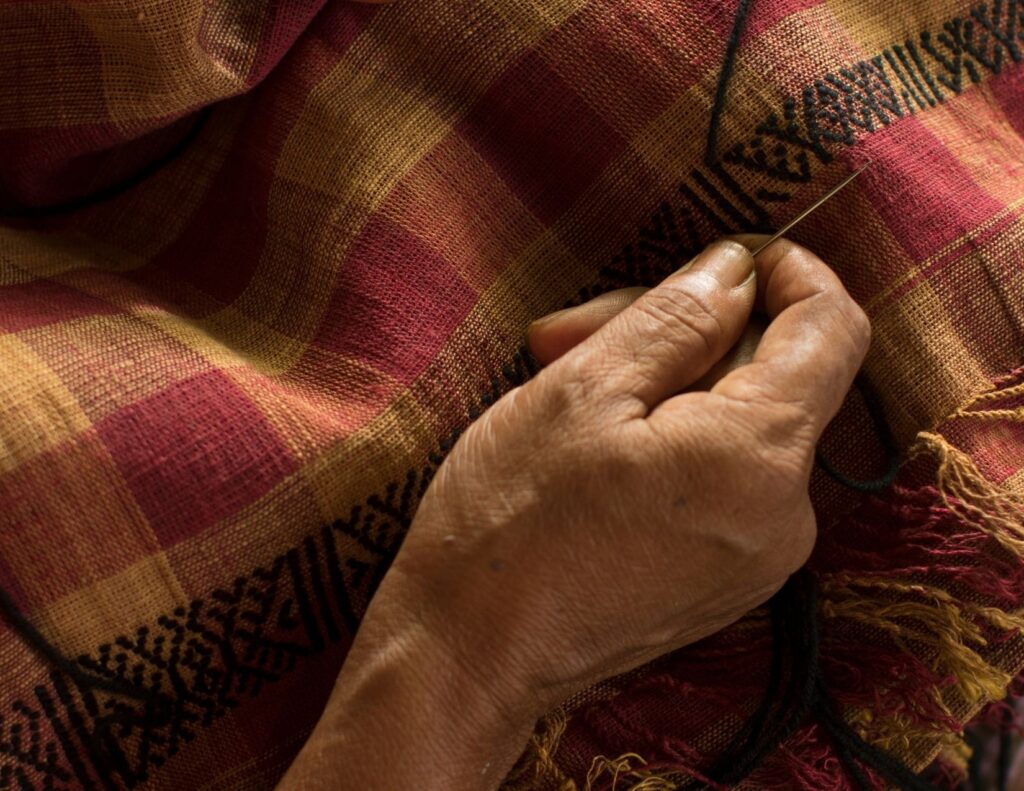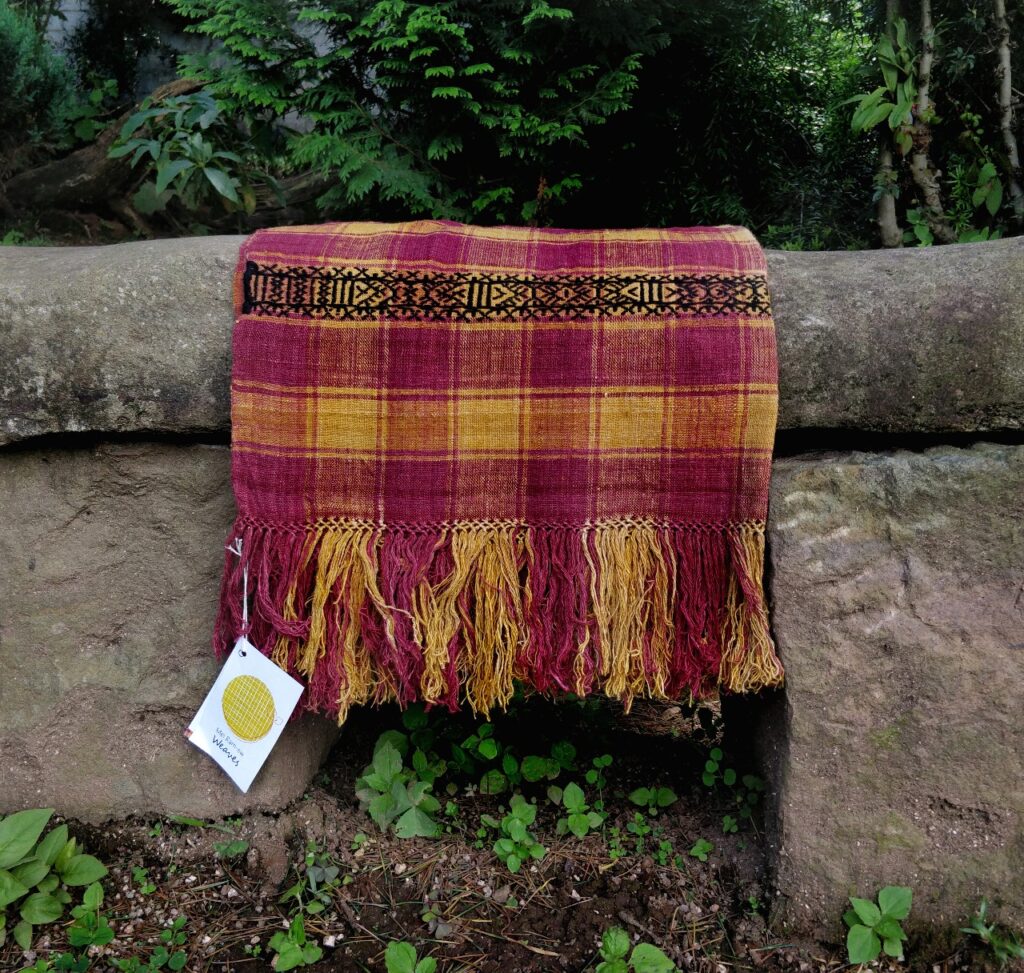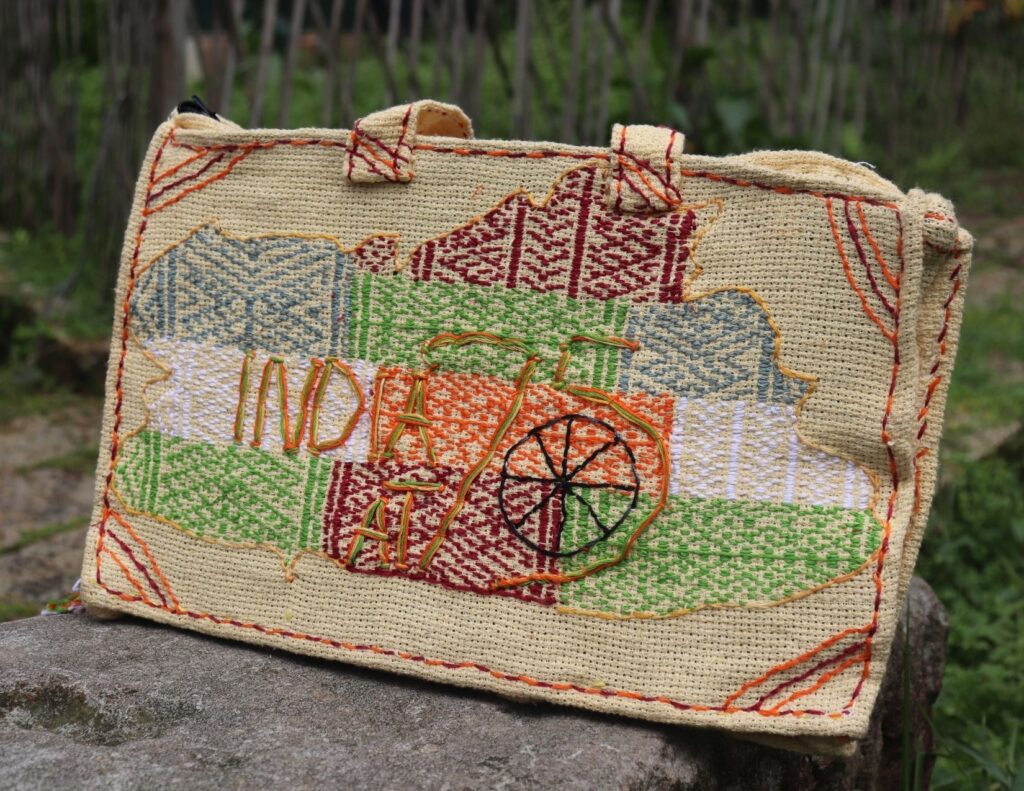The genesis of the word ‘Khneng’ (local Khasi word) basically means ‘border’. The inspiration for the embroidery comes from a local insect in the surrounding called ‘ktiar’, which resembles a centipede. A single line of a thick band is stitched on one side of the ‘jaiñpïen’ (a wrap-around) vertically. On a shawl, a line of a thicker and thinner band of Khneng embroidery is stitched horizontally. Two lines of embroidery are always stitched together on the shawl. In relation to this, it may be mentioned that the only known village for Khneng embroidery is Mustoh village, which is located near the Bangladesh border in Shella Bholaganj Block of East Khasi Hills District in the State. It is situated 80 km away from the State’s capital, Shillong.
The art of Khneng embroidery can be traced back to around 200 years ago. Though the history is not clear as to how it came to life, but the word of mouth from the locals suggest that the embroidery is stitched on the Eri fabric (silk locally known as jain ryndia) to decorate the border of the traditional garments. The fabric which is regularly used as the base cloth for the Khneng is the Eri silk. The Eri fabrics are not locally woven in the village but are bought from another district in Meghalaya, mainly from Ri-Bhoi District which is approximately 134 km from Mustoh village. Women are the majority of the population that work with Khneng embroidery. The techniques that are used in the art of Khneng embroidery are needles and threads with basic running stitches and with an attentive application of the mind, eyes, and hands.
One of the most important elements in working with embroidery is the thread count. The thread count gives evenly distributed motifs on the fabric. The women start stitching the motifs from the middle part of the Khneng and work their way from there count by count and part by part. Traditionally, black wool is used on the checked Eri fabric because it balances the thickness of the fabric and the spaces of the checks. According to the artisans, fabric weaved with thicker yarn is easier to stitch than a finer weaved fabric because it causes less stress to the eyes when counting the weaves/threads. They have also explored different threads on different fabrics; Eri threads on Eri shawls, Eri threads on cotton shawls, cotton thread on Eri shawls, thinner wool in Eri and cotton shawls. However, the artisans expressed that cotton threads are more suitable to use on Eri fabric, both coarse and fine quality. Artisans have a difficult time to stitch on a finer quality Eri fabric because their eyes get confused when counting the threads, so, they tend to distribute the spaces between the motifs by eyeballing them (Source:https://old.nesfas.in/traditional-embroidery-technique-meghalaya-khneng)
NESFAS’s association with Khneng embroidery started way back in 2015. Back then in Mustoh village, there were only three artisans who mastered the art of Khneng embroidery. In 2015 – 2016, NESFAS organized workshops on the preservation of Khneng and capacity building of the Artisans’, under the constant support and guidance of Lajoplin Nongsiej and Anna Louise Meynell who have been working closely with the artisans for years. The journey then continued with follow up programmes for sustaining the art. At the moment, female artisans are increasing in the art of Khneng embroidery. In fact, NESFAS’s visit to Mustoh village in 2018 has helped and assisted these women in strengthening their skills and passion towards the art by forming a group. NESFAS in collaboration with the artisans, formed a group named “Mei Ramew Khneng Embroidery Society, Mustoh”. Within this group, they aim to revive the dying art and enhance skill level and market sensitization. This group have also work to contemporize products with Khneng embroidery and try to increase the number of artisans within their society to sustain this traditional embroidery technique.
In its endeavour to increase its production, the group members have shared that getting seasonal orders from very few clients, find it difficult for them to transfer knowledge from the elder Khneng artisans to the younger generation who do not want to venture into something that does not look too promising. Khneng embroidery alone would not be a viable livelihood activity at present. Therefore, these local artisans are also involved in other local livelihood activities like teaching, maintaining small local shops and mainly farming. Cultivation of pineapples, mangos, sohramdieng, jack fruit, litchi, wild pepper and areca nut form a major part of their income from sale in weekly ‘haats’ (local markets).
On August 7, the Department of Arts and Culture and the Department of Textiles, Government of Meghalaya, in collaboration with NESFAS, concluded the “Khneng Embroidery Competition” on the occasion of National Handloom at Mustoh village, East Khasi Hills District. The competition was part of the India@75 and Meghalaya@50 programmes celebrating the indigenous and artistic tribal dexterity in weaves and was participated by eight weavers from the village. The chief guest of the occasion Frederick Kharkongor, Commissioner and Secretary, Textiles, while congratulating the participants encouraged the artisans to work hard together with the Textiles Department of the State to help make Mustoh the First Traditional Embroidery village in Meghalaya.
Pius Ranee, Executive Director, NESFAS says, “Although NESFAS works with communities to defend the Indigenous Food Systems, the organisation also realises the importance of understanding the culture and tradition embedded within the community. For Mustoh, it is the Khneng”, which is why the organisation has been closely working with the Mustoh community to revive the indigenous art form. Today, as the Government of Meghalaya acknowledges this unique art of Khneng embroiderers, Victory Synrem, who was one of the only three custodians in the whole of Meghalaya – 5 years ago, expresses her gratitude towards NESFAS for helping revive the Khneng. She further shared “We now have 18 women who are skilled in Khneng embroidery. All this is because of NESFAS. They helped us keep the art and tradition of Khneng alive. They helped in facilitating pieces of training for us to improve the technique as well as small scale marketing”.

Bah Pius Ranee Executive Director, NESFAS addressing the participants and the chief guests at the event
During this programme, Dipica Lyngdoh, Zonal Officer, Department of Textiles, who will be overseeing the training programmes to be organised in the near future, shared her hope that the collaboration between the weavers, embroiderers, NESFAS and Department would go ahead in full capacity. The next step of this joint collaboration is a project focused on the capacity building of the potential local weavers and embroiderers. This is to increase the number of artisans, strengthen the supply and value chain, and most importantly, keep the artforms alive. This was also supported by Darling Marwein, Engineering Supervisor, Department of Textiles who welcome the community members to “make use of the training centre for all necessary purposes – weaving, textiles, marketing, embroidery, and much more”. It may be mentioned that the Department is also actively working on a GI tag for Ryndia (Eri silk) and the same is in the plan for Khneng.
NESFAS aims to enhance local livelihood activities, such as this and the prime aim of the organization as of now is to provide the artisans with a platform to showcase and market their products. NESFAS aims to work towards refining the art and amplify the skills of the local youth who are interested in Khneng embroidery. As elaborated by Alex Mukhim, SDO, Sohra Sub-Division – preserving and enhancing the skill of Eri silk shawl with Khneng embroidery is a significant step to recognize and promote our traditional art and practices.
 Translate
Translate







